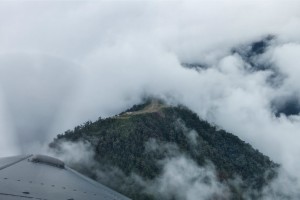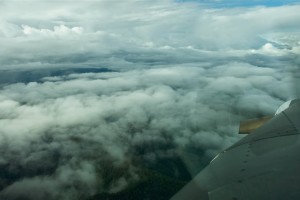 |
| Cloudy approach into Tsinga, Papua |
It’s very easy as a pilot to get “caught up in the moment” trying to make the landing and lose track of how much time you’ve spent doing so. For example, sometime there can be a breeze blowing which causes the clouds to reveal the airstrip, so you setup for a nice final approach but then another band of clouds blows over the airstrip, forcing you to abort. This kind of weather can easily cause you to get sucked into making a successful landing no matter what, especially as you just saw the airstrip.
 |
| Typical wet season clouds in Papua |
Our company SOPs (standard operating procedures) stipulate we can only make two attempts at a landing and if both are unsuccessful, we are to RTB (return to base). This is a good practice but sometimes the cloud layers can be enough that even getting down through them into a position to make at attempt at landing can take a surprisingly long time. It’s not unusual to have to fly 5-10nm away from an airstrip above a cloud layer to find a hole further down a valley and then fly back along under the clouds to get to the airstrip.
 |
| Fog on the ground at Bilogai, Papua |
One of the hardest things as a pilot is to know when enough is enough and even though you might be able to see the airstrip from directly overhead, the approach is just too covered in clouds for a safe approach. It’s very easy to keep trying increasingly risky manoeuvres and before you know it you’ve entered a cloud with mountains all around you. Not a good place to be. It is imperative you remain visual at all times during an approach to land.
 |
| Sinak airstrip is down there somewhere… |
So, in order to prevent myself starting to try potentially risky manoeuvres to land at an airstrip, I start a timer as soon as I get overhead. If I haven’t landed by 12 minutes (0.2hrs), I return to base. By my reckoning if you arrive overhead and airstrip and cannot make a safe landing within 12 minutes then it’s probably one of those days where you have to concede the weather just wasn’t suitable for landing. This is not to say I give up at the first sign of clouds and orbit around overhead for 12 minutes; I will try to locate a safe passage into the airstrip throughout the 12 minutes whilst remaining visual at all times.
Obviously the weather and approach are things you have to judge on a case by case basis there are some places you just cannot get to unless the whole approach and valley are clear. There’s also days when the weather is just far to poor to even think about descending into a valley for risk of ending up in a cloud or worse. However, on those marginal days I find this rule a handy way of keeping track of how long I’ve spent attempting to land and ensures I don’t do something silly. I’m sure many pilots have similar rules they set themselves but I thought I’d share mine on the off-chance it helps stop a fellow pilot doing something silly whilst attempting a landing.
Discover more from Matt Dearden
Subscribe to get the latest posts to your email.

I was very interested in this rule.
thanks sharing.
No worries, hope it might prove useful for you in the future.
So a good pilot is a pilot that does not get surprised???…Thanks Matt!! Enjoy
Surprises in aviation are usually a bad thing so anything you can do to keep things standard and safe are always a good idea.
Just discovered your site Matt. Love your philosophy and skill set. There are pilots and there are aviators, you fall into the Ernest K. Gann category!
Thanks Michael! Not sure I could compare myself to someone like Mr. Gann but I do enjoy aviating and writing about it. Cheers!
These pictures are so breath-taking. I was born and raised in Indonesia, but I’ve never explored my home country while I lived there. Now, I live in the USA, and I find it hard to visit home and explore at the same time because I want to spend more time with my family. Seeing these kinds of pictures is just a way for me to “explore.”
Glad to be able to show you some of your wonderful country Christella. I hope to bring plenty more in this new year.
I´ve been following all the episodes of “Worst place to be a pilot” TV series and are amazing. After the years, I´m now discovering your blog and is really interesting, specially this kind of flying tips I find very useful because I think pilots should never stop learning. Like you said, “Surprises in aviation are usually a bad thing”. I´m proud of being part of the only one ultralight formation flight team at Spain (Patrulla Plus Ultra), and sadly we have no partners support so we have to care about us and our planes to maintain them airworthy and to keep that surprises away. It´s always good to learn from the best!
Thanks Matt!